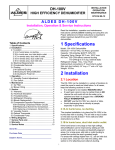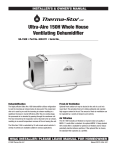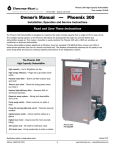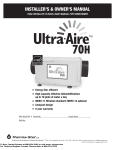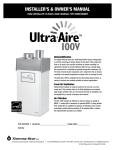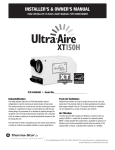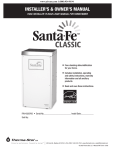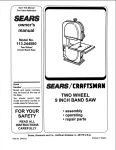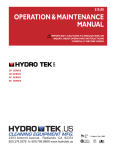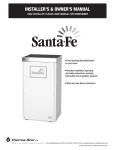Download American Aldes DHV-150H Specifications
Transcript
DHV-150H DEHUMIDIFYING VENTILATOR INSTALLATION OPERATION MAINTENANCE 782DHV12-00 DHV-150H Indoor Air Quality System Installation, Operation & Service Instructions Table of Contents 10. Optional Parts List .......................................... 17 11. Accessories..................................................... 17 12. Warranty Terms ............................................... 18 1. Specifications ................................................... 1 2. Installation......................................................... 1 2.1 Location ........................................................ 1 Serial No. ________________________________ 2.2 Electrical Requirements ................................ 2 2.3 Condensate Removal.................................... 2 Purchase Date ____________________________ 2.4 Ducting ......................................................... 3 2.4A Installing Duct Collars............................. 3 Dealer's Name ____________________________ 2.4B Ducting for Dehumidification................... 3 2.4C Ducting for Fresh Air .............................. 3 Read the installation, operation and maintenance 2.4D Constant Airflow Regulator Option.......... 4 instructions carefully before installing and using this 2.4E Installation in a basement ....................... 4 unit. Proper adherence to these instructions is essential 2.4F Installation in an attic.............................. 4 to obtain maximum benefit from your DHV-150H 2.4G Installation with (2) HVAC systems ......... 4 (Dehumidifying Ventilator) Indoor Air Quality System. 2.4H Installation without an HVAC system ...... 4 2.5 Quiet Installation ........................................... 5 3. Operation........................................................... 7 3.1 Humidity/Fan Control Panel .......................... 7 3.2 Ventilation Timer & Humidity Control Panel ... 7 Model: DHV-150H Indoor Air Quality System 3.3 Humidity Control Adjustment ........................ 7 Electrical: 110-120 VAC, 12 Amps, 60 Hz, grounded 3.4 Fan/Filter Switch........................................... 7 Capacity: 145 pints/day @ 80°F, 60% RH 3.5 Ventilation Timer .......................................... 7 Operating Temp. Range: 53°F min., 105°F max. 3.6 High Efficiency Air Filter ............................... 8 Air Flow: 400 CFM without external ducting 3.7 Low Pressure Control.................................... 8 290 CFM @ .40 IWG external static 4. Maintenance ...................................................... 9 Refrigerant Charge: 2 lb., 2 oz. R-22 4.1 Standard Air Filter......................................... 9 Duct connections: round 10" & 6” inlets, 10” outlet 4.2 High Efficiency Air Filter ............................... 9 Filter Size: Pleated cloth: 2” X 20” X 24” 4.3 Fresh Air Return ........................................... 9 High Efficiency: 4” X 20” X 24” 5. Service............................................................... 9 Size (w/o duct collars): 5.1 Warranty Notice............................................ 9 46" long x 25" wide x 20.5 " high 5.2 Technical description .................................... 9 Installed Weight: 145 lb. 5.3 Troubleshooting .......................................... 10 5.4 Refrigerant Charging .................................. 11 5.5 Fan Replacement ....................................... 11 5.6 Compressor/Capacitor Replacement........... 11 5.6A Checking Compressor Motor Circuits..... 11 2.1 Location 5.6B Replacing Burned Out Compressor........ 12 5.6C Replacing Compressor-Nonburn Out ...... 12 The DHV-150H can be installed in a variety of locations 5.7 Remote Controls......................................... 12 to meet the owner's needs as listed below. In all cases 5.7A Humidity Control.................................... 12 keep the following cautions in mind: 5.7B Ventilation Timer ................................... 13 • Install the unit INDOORS IN A SPACE THAT IS 5.8 Defrost Thermostat ..................................... 13 PROTECTED FROM FREEZING AND 5.9 Electric Ventilation Damper ........................ 13 FLOODING. 5.10 Low Pressure Control ................................ 13 • Install the unit with space to access the front panel 5.11 Condensate Pump Kit ............................... 13 for maintenance and service. Also allow easy 6. Electrical Schematic ....................................... 14 access to the filter cover panel. DO NOT INSTALL 7. Pictorial Electrical Diagram............................ 15 UNIT WITH THE FRONT PANEL OR FILTER 8. Service Parts List............................................ 16 COVER PANEL INACCESSIBLE. 9. The DHV-150H ................................................. 16 F:\W06\AldesW06\DOCFILES\782DHV-150HInst.doc 782DHV150H-10-00 Rev:10/30/2002 1 Specifications 2 Installation • • • • (pool, spa room, or basement prone to flooding), a ground fault interrupter protected circuit is required. Avoid discharging the air directly at people, or over the water in pool areas. If used near a pool or spa, be certain there is NO chance the unit could fall into the water or be splashed and that it is plugged into a GROUND FAULT INTERRUPTER. DO NOT use the DHV-150H as a bench or table. A drain pan MUST be placed under the unit if installed above a living area or above an area where water leakage could cause damage. Install the remote control panel in a central area of the structure where it will sense the relative humidity of the structure accurately. Avoid installing the control panel near HVAC supply registers, exterior doors, a pool or spa. The installer must supply the wiring between the DHV-150H and the control panel. Be sure to safely route the control wiring to prevent damage during installation. Be careful not to cross the wires when connecting the DHV-150H and the remote control panel or damage to the transformer may result. Place the DHV-150H on supports that raise the base of the unit above the top of the flanges on the drain pan beneath it. Raising the DHV-150H will help the unit drain with gravity flow. Do not place the DHV-150H directly on structural building members without vibration absorbers or unwanted noise may result. The remote controls of the DHV-150H are powered by a low voltage circuit (24 Vac) and must NEVER contact or be connected to a high voltage circuit. The control wires leaving the DHV-150H and the remote control panels are numbered and color-coded to prevent confusion. Some of the control wires leaving the DHV150H may not be used with certain control panels and should be left safely disconnected with wire nuts taped onto the stripped ends. Be sure to consult the electrical schematic in this manual or inside the access panel of the DHV-150H before making the control connections. The DHV-150H may be suspended with steel hanger straps (plumbers tape) or a suitable alternative from structural members. Remember to place a drain pan under the unit if it is suspended above a finished area or above an area where water leakage could cause damage. The DHV-150H should be located near the existing air handling system to minimize the required ductwork for connecting the DHV-150H to the existing air handling system. The controls for the DHV-150H are remote from the unit and must be located in the space that is to be conditioned. The controls are low voltage (24 volt) and should be connected to the DHV-150H with low voltage thermostat cable. WARNING: DO NOT ALLOW THE YELLOW LEAD FROM THE DHV-150H TO CONTACT THE RED LEAD OR ORANGE LEAD FROM THE DHV-150H OR DAMAGE TO THE TRANSFORMER WILL RESULT. NOTE: RESET THE VENTILATION TIMER BEFORE ATTEMPTING TO PROGRAM AFTER INITIAL INSTALLATION. THE TIMER MAY NOT OPERATE CORRECTLY UNTIL IT IS RESET. An external insulation kit is available for the DHV-150H. This will prevent the cabinet from sweating if the unit is installed in an unconditioned space. This kit will also increase the efficiency of the unit by eliminating unwanted heat transfer between the unit and the unconditioned space. See the optional parts list for information on the kit. If an extension cord is required, it must have a minimum of 12 gauge conductors if 25 feet long or less and 10 gauge conductors if greater than 25 feet long. 2.3 Condensate Removal If fresh air ventilation is desired, thought should be given to the location for the fresh air ducting. A 6” round insulated duct will have to be installed on the DHV150H and run to the outside of the structure to bring in fresh air. Use an 8” insulated round duct for lengths of more than 50 feet or if more than 100 CFM is needed. Consult local codes for necessary distances from exhaust ports when installing fresh air return. Condensate drains by gravity via the clear hose extending from the unit. Route the hose to a suitable drain. Use care to keep the hose as flat to the floor as possible, excessive humps will prevent proper drainage. If the DHV-150H is located too far from a drain for the attached hose to reach, inexpensive 1/2" PVC pipe can be used to extend it. It is commonly available in 10' lengths from building supply, plumbing or hardware stores. It will slide tightly inside the end of the drain hose. If more than one length of pipe is required, they can be joined with a short piece cut from the end of the drain hose. 2.2 Electrical Requirements The DHV-150H plugs into a common grounded outlet on a 15 or 20 Amp circuit. It draws around 12 Amps under normal operating conditions. If used in a wet area 2 Ducting the DHV-150H as mentioned in sections 2.4A2.4G requires consideration of the following points: An optional condensate pump kit may be installed if a lift is required to dispose of the condensate. The condensate pump kit can be ordered direct from the factory. See the optional parts list for information on the kit. Duct Sizing: For total duct lengths up to 25', use a minimum 10" diameter round or equivalent rectangular. For longer lengths, use a minimum 12" diameter or equivalent. Grills or diffusers on the duct ends must not excessively restrict airflow. 2.4 Ducting Isolated Areas: Effective dehumidification may require that ducting be branched to isolated, stagnant areas. Use 8" or larger diameter branch ducting to each of two or three areas, use 6" or larger to each of four or more areas. 2.4A Installing Duct Collars The DHV-150H is equipped with 10” and 6” round inlet collars and a 10” round exhaust collar. The 10” and 6” round inlet collars are designed with tabs that fold inside the filter enclosure of the DHV-150H. The 10” round exhaust collar is attached to the DHV-150H by folding the tabs inside the end panel of the DHV-150H. Connecting to existing HVAC systems: An optional 10" check damper is available from the factory to prevent reverse flow through the DHV-150H. If the DHV-150H is ducted to the supply of a high static air handler the check damper may be placed in the DHV-150H supply duct. 2.4B Ducting for Dehumidification For the ideal installation, draw air from the central part of the home and return it to the isolated areas of the home like the bedrooms, den, utility room, or family room. The ductwork of the existing heating system can be used to supply air to the home. If the existing supply goes to isolated areas of the home, discharge the supply of the DHV-150H into the supply of the existing heating system. If the existing heating system incorporates a central supply, installation of a separate supply duct from the DHV-150H to each isolated area is recommended. DO NOT draw air directly from the kitchen, laundry, or isolated basement. You may draw air from a basement that is open to the home. All flexible ducting connected to the DHV-150H should be UL listed. 2.4C Ducting for Fresh Air Fresh air can be brought into the structure by connecting a insulated duct from outside to the 6” DHV150H inlet and by turning on the fan switch or activating the humidity control (on units with the humidity control panel). Activate the ventilation timer on units with the ventilating & humidity control panel to bring in fresh air. Refer to section 3.5 for programming instructions for the ventilation timer. Advantages of this form of ventilation include: 1. Outside air is filtered before entering the building. 2. Outside air will be dehumidified before entering if the DHV-150H is running in dehumidification mode. 3. Drawing air from outside and blowing inside aids in slightly pressurizing the structure. This helps prevent dirty and humid air from entering elsewhere. It also reduces the potential for carcinogenic radon gas to enter and provides make-up air for open combustion and exhaust devices like the clothes drier, fireplace, and water heater. 4. The need for an alternate ventilation device may be eliminated. The inlet of the DHV-150H is the 10” diameter hole in the filter enclosure of the unit. A 10” round collar is supplied with the unit to attach to round duct. The duct may be permanently attached to the collar. A 6” round collar is provided with the unit to attach to the 6” hole in the filter enclosure. The 6” collar should be capped if fresh make-up air is not desired. If fresh make-up air is desired see section 2.4C. The outlet of the DHV-150H is located on the end of the unit. A second 10” round collar is supplied with the unit. Cut and remove the safety grid, then bend the tabs on the collar inside the hole in the cabinet end. In cold climates or areas where the outdoor dew point is low at times, ventilation can be used to dehumidify the structure. This approach is often more economical than running the dehumidifier to remove excess moisture from the structure. For example, in a house that experiences condensation on the interior surface of the windows during the winter, increasing the amount of ventilation will often cure the problem. A length of 10 feet or more of acoustical flex ducting on the outlet of the DHV-150H will reduce air noise from the fan. A length of flexible ducting on all DHV-150H duct connections is recommended to reduce noise and vibration transmitted to rigid ductwork in the structure. An insulated 6" diameter duct is generally sufficient to provide up to 150 CFM of outside air. Large quantities of outside air will impact DHV-150H performance 3 duct from outside to the 6” collar of the DHV-150H if you wish to provide optional fresh make-up air. positively or negatively, depending upon the inside and outside air conditions. Consult the factory by calling 1800-255-7749 for recommendations regarding the use of higher flows with your specific application. 2.4F Installation in an Attic with an Existing Forced Air HVAC System The outside air duct should be connected to the 6” round collar on the filter enclosure of the unit. The 6” round collar includes a manual damper. Adjust the manual damper to provide the desired amount of fresh air for ventilation. The amount of fresh air should be based on the size and occupancy of the residence. If you are unsure of your ventilation air requirements, consult the factory by calling 1-800-255-7749 for assistance. ALWAYS install a catch pan with a drain or float interrupt for condensate under the DHV-150H in an attic or condensate may drip down on the ceiling of the living space below. Locate a separate return for the DHV-150H in a central area of the structure. Duct the supply of the DHV-150H to the air supply of the existing HVAC system. Connect an insulated duct from outside to the 6” collar of the DHV-150H if you wish to provide fresh make-up air. 2.4D Constant Airflow Regulator and Vent Hood Options 2.4G Installation in a Structure with Two Forced Air HVAC Systems American ALDES offers the fresh air vent hood and constant airflow regulators (CAR) to control the amount of fresh air entering the home. These are used in lieu of the manual damper in the 6” collar on the main unit. The CAR, inserted in the vent hood collar, automatically maintains the desired airflow, independent of pressure. A CAR is recommended for installations where the DHV draws return air from a shared HVAC system return duct, to avoid excessive ventilation when the HVAC fan cycles on. If the indoor air return is independent of the HVAC system, the CAR is not necessary, as the manual damper may be set to the desired airflow. Attach the DHV-150H return to an independent return from the upper level. Attach the DHV-150H supply to the supply of the basement HVAC system. This will promote circulation of air through the whole structure from the upper level to the lower level through the DHV-150H. If the DHV-150H is not connected to both areas, it will not control the humidity and ventilation of the entire structure. Connect an insulated duct from outside to the 6” collar of the DHV-150H if you wish to provide fresh make-up air. 2.4H Installation in a Structure with No Existing Forced Air HVAC System 2.4E Installation in a Basement or Crawl Space with an Existing Forced Air HVAC System When installing the DHV-150H in a structure that does not have a forced air HVAC system, a single return for the DHV-150H should be installed in central open area of the structure. DO NOT locate the return in a bathroom or a kitchen. The supply of the DHV-150H should be located in the remote areas of the structure (such as bedrooms, den, etc.). By ducting this way, the air inside the structure will circulate through the DHV150H to be filtered and dehumidified. 4" diameter duct is recommended for branches to the bedrooms, 6" diameter duct is recommended for branches to larger areas. Refer to section 2.4B for branch duct sizing. Connect an insulated duct from outside to the 6” collar of the DHV-150H if you wish to provide fresh make-up air. If the structure in which the DHV-150H is to be installed has an existing forced air HVAC system, utilize the HVAC system to make the DHV-150H installation easier. Basement Installation: Install a separate return for the DHV-150H in a central area of the structure. Duct the supply of the DHV-150H to a 10” x 10” x 10” tee/damper that is 30% open to the basement. Duct the other side of the tee to the air supply of the existing HVAC system. Connect an insulated duct from outside to the 6” collar of the DHV-150H if you wish to provide optional fresh make-up air. Crawl Space Installation: Install a separate return for the DHV-150H in a central area of the structure. Duct the supply of the DHV-150H to a 10” x 10” x 10” tee/damper that is 30% open to the crawl space if desired. Duct the other side of the tee to the air supply of the existing HVAC system. Connect an insulated 4 2.5 Quiet Installation Remove Shipping Restraints The compressor is attached to the cabinet with two cable ties to secure it during shipment. This rigid attachment is not necessary once the unit is installed and may cause noise from compressor vibration. AFTER INSTALLATION, CUT THE CABLE TIES TO FREE THE COMPRESSOR FROM THE CABINET. REMOVE THE HORIZONTAL CABINET SUPPORT TO WHICH THE COMPRESSOR IS ATTACHED. The ends of the support are notched so that the support can easily be removed. Cut the strips of metal on each end and remove the support section from the cabinet. This will prevent the compressor from transmitting vibration to the cabinet. Make sure none of the compressor tubes are pressed against the cabinet or access panel. Check that the compressor tubes are centered in the holes where they pass through the drain pan. A length of 10 feet or more of acoustical flex ducting on the outlet of the DHV-150H will reduce air noise from the fan. A length of flexible ducting on all DHV-150H duct connections is recommended to reduce noise and vibration transmitted to rigid ductwork in the structure. 5 Figure 1: DHV-150H in a Basement With a Forced Air System Incorporating a Central Return Figure 2: DHV-150H in an Attic with a Forced Air System Incorporating a Central Return 6 3.3 Humidity Control Adjustment 3 Operation Set the humidity control to the desired humidity level for the home. The dehumidifier will run continuously until the relative humidity (RH) is reduced to the humidity control dial setting. Setting the humidity control to lower RH levels will NOT increase the unit's dehumidification rate; the unit will simply run longer to reduce the area's RH to the setting. The DHV-150H unit (and refrigerant-based dehumidifiers in general) will reduce a warm space's RH to a lower level than that of a cool space. It is therefore pointless to set the humidity control to excessively low levels in cool rooms; doing so will result in long periods of ineffective dehumidifier run time. The DHV-150H can be equipped with various accessories to enhance its operation. A remote control panel must be used with the DHV-150H. There are two remote control panels from which to choose. The humidity/fan control panel is used to control humidity and the fan. The ventilation timer and humidity control panel is used to control ventilation, humidity and the fan. 3.1 Humidity/Fan Control Panel See Figure 7: The humidity/fan control panel automatically controls the humidity of the living space. The humidity/fan control panel contains an adjustable humidity control and a fan switch. This panel should be mounted in a central area of the structure where it can accurately sense the humidity of the air in the living space. The panel has a cover that must remain open to the air within the living space for accurate humidity sensing. Quality humidity meters are available from the factory and are recommended to accurately monitor humidity levels. 3.4 Fan/Filter Switch Turning ON the fan/filter switch will cause the central conditioning unit's internal fan to run continuously, whether the central conditioning unit is dehumidifying or not. This function is desirable if the central conditioning unit is used for air circulation and filtration to achieve maximum indoor air quality. When the switch is ON; air will be constantly filtered through the central conditioning unit and circulated throughout the house. When the switch is OFF the fan will operate only when the humidity control calls for dehumidification or when the ventilation timer calls for ventilation. The humidity/fan control panel can be used in conjunction with the optional fresh air damper. When used with the optional fresh air damper, the fan/filter switch will act as a fresh air ventilation control. When the switch is ON (in this configuration), the fan will run, the fresh air damper will open, and fresh air will be filtered and brought into the structure. When the switch is OFF, the fresh air damper will close and the fan will operate only when the humidity control calls for dehumidification. Contact the factory for instructions on this type of installation. 3.5 Ventilation Timer 3.2 Ventilation Timer and Humidity Control Panel The ventilation timer controls the fan and the motorized fresh air damper. When the ventilation timer is activated, the central conditioning unit will circulate the indoor air, and bring in fresh air from outside. The ventilation timer should be set for the required ventilation of the residence. The home should be ventilated with fresh air as suggested by applicable codes and standards. See Figure 7: The ventilation timer and humidity control panel automatically controls both the ventilation and the humidity of the living space. The ventilation timer and humidity control panel contains an adjustable humidity control, a fan switch, and a ventilation timer. This panel will control the humidity and allow programmed ventilation of the living space. This panel works in conjunction with the optional fresh air damper to provide ventilation. In cold climates or areas where the outdoor dew point is low at times, ventilation can be used to dehumidify the structure. This approach is often more economical than running the dehumidifier to remove excess moisture from the structure. For example, in a house that experiences condensation on the interior surface of the windows during the winter, increasing the amount of ventilation will often cure the problem. This panel should be mounted in a central area of the structure where it can accurately sense the humidity of the air in the living space. The panel has a cover that must remain open to the air within the living space for accurate humidity sensing. 7 The ventilation timer is an electronic timer that displays the current time. This timer has a battery backup, so it will not require resetting after a power outage. Following a prolonged power outage the display of the timer will flash on and off indicating a power outage has occurred. The one-minute time increments of the ventilation timer allow you to program the ventilation of your home to fit your schedule. turn off time for the first program. Set the turn off time using the 1…7, h, and m buttons in the same way as described above and continue on to the second through sixth programs. When setting the ventilation programs, you can return to the current time display by sliding the switch in the upper right corner of the timer to RUN. The slide switch in the upper right must be set to RUN for the timer to operate with the scheduled programs. The ventilation timer has six programs with each program having one “on” and one “off” event. A program allows the user to turn the ventilation on at a certain day and time, then it allows them to turn the ventilation off at a certain day and time. Each of these programs can be repeated daily or weekly or during a specified block of days. All six of the programs operate independently of each other. The slide switch in the upper left of the timer is used to choose between automatic and manual operation of the timer relay. When the slide switch in the upper left of the timer is set to AUTO mode, the central conditioning unit will ventilate when the scheduled programs call for ventilation. When the slide switch in the upper left of the timer is set to manual (set to hand symbol on the right), the operation of the timer is controlled by the I/O button only. Pressing the I/O button will switch the ventilation timer between ON (detent) and OFF (detent). As you press the I/O button, “ON” or “OFF” will be displayed to the right of the time. The “ON” or “OFF” to the right of the time will indicate if the ventilation timer is on or off. The I/O button will manually override scheduled programs if the timer is in AUTO mode. If the timer fails to operate or operates erratically, check that the control panel receives 24Vac from the DHV-150H. If 24Vac is present at the control panel, reset the timer by pressing the reset button at the bottom center of the timer face. The reset button is the small recessed button with an R beneath it located below the 1…7 and h buttons. Press the reset button in until the display clears. Release the reset button. The display will reappear as 00:00. Resetting the timer will clear the time and all program settings. After resetting the timer follow the instructions below to set the correct time and ventilation programs. 3.6 High Efficiency Air filter An optional high efficiency air filter is available for the DHV-150H. ASHRAE Dust Spot Test Method 52-76 rates this filter 90-95% efficient. This filter is much more efficient than the standard air filter and is able to catch much smaller particles that can aggravate allergies. The following instructions explain how to set the ventilation timer. First, set the correct time on the timer by sliding the switch in the upper right hand corner of the timer to the clock symbol ⊕ and pressing the 1…7 (DAY), h (HOUR), and m (MINUTE) buttons. Remember that this timer operates on a 24-hour (military time) clock. The high efficiency air filter is 4 inches thick and should be installed in the filter enclosure directly behind the standard air filter (See Figure 7). The standard air filter will act as a prefilter for the high efficiency air filter and will prolong the life of the high efficiency air filter. Next, set the ventilation time schedule. Slide the switch in the upper right hand corner to the program symbol P. “ON” will appear to the right of the time and the number “1” will appear in the lower right hand corner of the display. The “1” and “ON” signify the turn on time for the first program. Press the 1…7 button to choose the days of the week for this program. You can choose Mon.-Sun, Mon.-Fri., Sat-Sun, or any single day of the week. The days chosen are shown along the top of the display on the ventilation timer. Next press the h button to set the hour for the start of the ventilation period. Remember that this timer operates on a 24-hour clock. Then press the m button to set the minutes past the hour to start the ventilation. Now, with the ventilation start time set; press the I/O button. The word “OFF” should appear to the right of the time and the number “1” should remain in the lower right hand corner of the display. The “1” and “OFF” signify the 3.7 Low Pressure Control If the low side refrigerant pressure drops to 15 PSIG, the low-pressure control opens and shuts off the compressor and fan. It is an automatically reset control that will close when the pressure rises to 35 PSIG. Its primary function is to prevent damage to the compressor if a leak develops in the refrigeration system. It may also open if the unit is A) installed in a cool area (below 50 F) or B) installed where it is below 40 F and then started. Under these conditions, the unit will restart within several minutes. Until the unit warms up, it may repeat the cycle several times. 8 5 Service 4 Maintenance CAUTION: Servicing the DHV-150H with its high pressure refrigerant system and high voltage circuitry presents a health hazard which could result in death, serious bodily injury, and/or property damage. Only qualified service people should service this unit. 4.1 Standard Air Filter The DHV-150H is equipped with a pleated cloth air filter. This filter should be checked semi-annually. Operating the unit with a dirty filter will reduce dehumidifier capacity and efficiency and may cause the compressor to cycle off and on unnecessarily on the defrost control. 5.1 Warranty Notice To access the air filter, remove the filter access panel from the end of the DHV-150H by unscrewing the two thumbscrews and sliding the panel to the left until it is free from underneath the side panel. The filter(s) should be readily visible and can be removed by pulling them straight out of the DHV-150H. Warranty terms are provided at the end of this manual. Please read the terms before any repair is initiated. If a warranty repair is required, call the factory first at 1800-255-7749 for warranty claim authorization and technical assistance. 5.2 Technical Description The pleated cloth filter can generally be vacuumed clean several times before needing replacement. Replacement filters can be ordered from the factory or purchased locally if available. DO NOT operate the unit without the standard filter or with a less effective filter than the standard filter. The heat exchange coils inside the unit could become clogged and require disassembly to clean. The DHV-150H uses a refrigeration system similar to an air conditioner's to remove heat and moisture from incoming air, and add heat to the air that is discharged (See Figure 3). 4.2 High Efficiency Air Filter An optional high efficiency pleated microglass paper filter is available for the DHV-150H. This filter is rated as 90%-95% efficient by the ASHRAE Dust Spot test method 52-76. The high efficiency pleated microglass paper filter should be used in conjunction with the standard filter, and placed directly behind the standard filter. This filter is able to remove allergy-causing particles from the airstream. Check the high efficiency air filter every two years and replace if necessary. The high efficiency filter has a much larger surface area than the standard filter, thus the standard filter may need to be cleaned or replaced several times before the high efficiency filter requires replacement. Be careful not to damage the fabric media when handling the high efficiency pleated paper filter. Do not attempt to clean the high efficiency pleated paper filter. It should be replaced when it becomes restrictive (See Figure 7). Figure 3: Refrigeration System of DHV-150H Hot, high-pressure refrigerant gas is routed from the compressor to the condenser coil (See Figure 3). The refrigerant is cooled and condensed by giving up its heat to the air that is about to be discharged from the unit. The refrigerant liquid then passes through a filter/drier and capillary tubing, which causes the refrigerant pressure and temperature to drop. It next enters the evaporator coil where it absorbs heat from the incoming air and evaporates. The evaporator operates in a flooded condition, which means that all the evaporator tubes contain liquid refrigerant during normal operation. A flooded evaporator should 4.3 Optional Fresh Air Return Check and clean the screen on the outdoor fresh air return seasonally. The screen may become plugged during the seasons when there are many particles in the outdoor air. 9 maintain nearly constant pressure and temperature across the entire coil, from inlet to outlet. Fan runs with fan switch ON. Fan does not run with ventilation timer activated. 1. Ventilation timer set to manual & switched OFF. 2. Time not correct on ventilation timer. 3. Defective ventilation timer. 4. Defective fan switch. The mixture of gas and liquid refrigerant enter the accumulator after leaving the evaporator coil. The accumulator prevents any liquid refrigerant from reaching the compressor. The compressor evacuates the cool refrigerant gas from the accumulator and compresses it to a high pressure and temperature to repeat the process. Evaporator coil frosted continuously, low dehumidifying capacity. 1. Dirty air filter(s) or airflow restricted. 2. Excessively restrictive ducting connected to unit. 3. Defrost thermostat loose or defective (Sec. 5.8). 4. Low refrigerant charge 5.3 Troubleshooting No dehumidification, neither fan nor compressor run with fan switch and ventilation timer OFF. 1. Unit unplugged or no power to outlet. 2. Humidity control set too high or defective (Sec. 3.3 & 5.7A) 3. Loose connection in internal or control wiring. 4. Defective Compressor relay. 5. Defective control transformer. 6. Low pressure Control open (Sec 3.7 & 5.10). 7. Optional Condensate Pump Safety Switch open (Sec 5.11). Unit not providing ventilation. Ventilation timer not operating correctly. 1. If timer is not functioning correctly reset timer and reprogram (Sec. 3.5). 2. Check control wire connections (check connections at fresh air damper also). 3. Defective fresh air damper (Sec. 5.9). 4. Defective fan switch. Unit removes some water, but not as much as expected. 1. Air temperature and/or humidity have dropped. 2. Humidity meter and or thermometer used are out of calibration. 3. Unit has entered defrost cycle (Sec. 5.8). 4. Air filter dirty (Sec. 4.1 & 4.2). 5. Defective defrost thermostat (Sec 5.8). 6. Low refrigerant charge (Sec. 5.4). 7. Air leak such as loose cover or ducting leaks. 8. Defective compressor (Sec. 5.6). 9. Restrictive ducting (Sec. 2.4). 10. Optional Condensate Pump Safety Switch open (Sec 5.11). No dehumidification, compressor does not run but fan runs with fan switch and ventilation timer OFF and humidity control turned to ON. 1. Defective compressor run capacitor (Sec. 5.6). 2. Bad connection in compressor circuit (See Fig. 4). 3. Defective compressor overload (Sec. 5.6A). 4. Defective compressor (Sec. 5.6). 5. Defrost thermostat open (Sec. 5.8). Fan runs with fan switch and ventilation timer OFF, but compressor cycles on & off. 1. Low ambient temperature and/or humidity causing unit to cycle through defrost mode. 2. Defective compressor overload (Sec. 5.6A). 3. Defective compressor (Sec. 5.6). 4. Defrost thermostat defective (Sec. 5.8). 5. Dirty air filter(s) or airflow restricted. 6. Low refrigerant charge, causing defrost control to cycle. 7. Bad connection in compressor circuit. Unit Test to determine problem: 1. Detach field control wiring connections from main unit. 2. Connect the yellow and green pigtails from the main unit together; only the fan should run. Disconnect the wires. 3. Connect the yellow and blue pigtails from the main unit together; the compressor and fan should run. 4. If these tests work, the main unit is working properly. You should check the control panel and field control wiring for problems next. 5. Remove the control panel from the mounting box and detach it from the field installed control wiring. Connect the blue, yellow, and green wires from the control panel directly to the corresponding colored pigtails on the main unit. Leave the violet, white and red wires disconnected! Fan does not run with fan switch in either position. Fan does not run with ventilation timer activated. Compressor runs briefly but cycles on & off with humidity control turned to ON. 1. Loose connection in fan circuit (See Fig. 4). 2. Obstruction prevents fan impeller rotation. 3. Defective fan. 4. Defective fan relay. 5. Defective fan capacitor. 10 6. Turn on the fan switch; the fan should run. Turn off the fan switch. 7. Turn on the humidity control; the compressor and fan should run. 8. If these tests work, the problem is most likely in the field control wiring. 2. Plug in the unit and turn the humidity control to ON. Check for 110 volts from compressor terminal R to overload terminal 3 using an AC voltmeter. If voltage is present, go to step 3. If no voltage, there may be a loose connection in the compressor circuit. Test each component for continuity. See the appropriate section if a defect is suspected. 5.4 Refrigerant Charging 3. Unplug the unit, and then disconnect the red and yellow wires from compressor terminals R & S. Using an ohmmeter check continuity between the points listed below. If the refrigerant charge is lost due to service or a leak, a new charge must be accurately weighed in. If any of the old charge is left in the system, it must be recovered before weighing in the new charge. Refer to the unit nameplate for the correct charge weight and refrigerant type. 4. Compressor terminals C and S: No continuity indicates an open start winding. The compressor must be replaced. Normal start winding resistance is 3 to 7 ohms. 5.5 Fan Replacement 5. Compressor terminals C and R: No continuity indicates an open run winding. The compressor must be replaced. Normal run winding resistance is .5 to 2 ohms. The motorized impeller is a unitary assembly consisting of the motor and impeller. If defective, the complete assembly must be replaced. 6. Compressor terminal C and overload terminal 1: No continuity indicates a defective overload lead. 1. Unplug the power cord. 2. Remove the cabinet access panel. 3. Remove the screw attaching the fan support bracket to the base. 4. Disconnect the fan leads inside the electric box. 5. Push up on the inlet ring and pull the fan and fan support bracket to the right, then up and out of the unit. 6. Remove the defective fan from the bracket and replace with new fan. 7. Reassemble the new fan by reversing the above procedure. 7. Overload terminals 1 and 3: If there is no continuity, the overload may be tripped. Wait 10 minutes and try again. If there is still no continuity, it is defective and must be replaced. 8. Compressor terminal C and compressor case: Continuity indicates a grounded motor. The compressor must be replaced. 9. Disconnect the wires from the run capacitor. Set the ohmmeter to the Rx1 scale. The capacitor is shorted and must be replaced if continuity exists across its terminals. If there is no needle movement with the meter set on the Rx100000 scale, the capacitor is open and must be replaced. 5.6 Compressor/Capacitor Replacement This compressor is equipped with a two terminal external overload and a run capacitor, but no start capacitor or relay (See Figure 4). 10. Reconnect the wires to the compressor and capacitor. Plug in and turn on the unit. If the compressor fails to start, replace the run capacitor. CAUTION-ELECTRICAL SHOCK HAZARD: Electrical power must be present to perform some tests. These tests should be performed by a qualified service person. 11. If the unit still does not start, adding a hard-start kit (relay & capacitor) will provide greater starting torque. If this doesn't work, the compressor has an internal mechanical defect and must be replaced. 5.6A Checking Compressor Motor Circuits Perform the following tests if the fan runs but the compressor does not with the fan switch and ventilation timer OFF and the humidity control ON. 5.6B Replacing a Burned Out Compressor The refrigerant and oil mixture in a compressor is chemically very stable under normal operating conditions. However, when an electrical short occurs 1. Unplug the unit; remove the cabinet side and the electrical connection cover on the compressor top. 11 7. Evacuate the system with a good vacuum pump and accurate vacuum gauge. Leave the pump on the system for at least an hour. in the compressor motor, the resulting high temperature arc causes a portion of the refrigerant oil mixture to break down into carbonaceous sludge, a very corrosive acid, and water. These contaminants must be carefully removed otherwise even small residues will attack replacement compressor motors and cause failures. 8. Operate the system for a short period of time, monitoring the suction pressure to determine that the suction filter is not becoming plugged. Replace the suction filter/drier if pressure drop occurs. If a severe running burn out has occurred, several filter/driers may have to be replaced to remove all of the acid and moisture. The following procedure is effective only if the system is monitored after replacing the compressor to insure that the clean up was complete. 1. This procedure assumes that the previously listed compressor motor circuit tests revealed a shorted or open winding. NOTE: NEVER use the compressor to evacuate the system or any part of it. 5.6C Replacing a Compressor, Nonburn Out 2. Remove and properly dispose of the system charge. DO NOT vent the refrigerant or allow it to contact your eyes or skin. Remove the refrigerant from the system. Replace the compressor and liquid line filter/drier. Charge the system to 50 PSIG and check for leaks. Remove the charge and weigh in the refrigerant quantity listed on the nameplate. Operate the system to verify performance. 3. Remove the burned out compressor. Use rubber gloves if there is any possibility of contacting the oil or sludge. 4. To facilitate subsequent steps, determine the type of burn out that occurred. If the discharge line shows no evidence of sludge and the suction line is also clean or perhaps has some light carbon deposits, the burn out occurred while the compressor was not rotating (standing burn out). Contaminants are therefore largely confined to the compressor housing. A single installation of liquid and suction line filter/driers will probably clean up the system. 5.7 Remote Controls Devices mounted on a panel that is remote from the unit control the DHV-150H. You may or may not have the devices listed below depending on the model of the remote control panel that you purchased. If the DHV-150H fails to operate as desired, always check the settings of the controls to insure that they are correct. Check that the controls are receiving 24Vac from the DHV-150H. Check the connections between the DHV-150H, the control panel, and the field control wiring. If sludge is evident in the discharge line, it will likely be found in the suction line. This indicates the compressor burned out while running (running burn out). Sludge and acid have been pumped throughout the system. Several changes of the liquid and suction filter/driers will probably be necessary to cleanse the system. 5.7A Humidity Control The humidity control is an adjustable switch that closes when the relative humidity of the air in which it is located rises to the dial set point. It opens when the RH drops 4 to 6% below the set point. If the DHV150H does not run, try turning the humidity control clockwise until it reaches the stop and the knob pointer points at “Max Dry” (see back of control panel cover.) 5. Correct the system fault that caused the burn out. Consult the factory for advice. 6. Install the replacement compressor with a new capacitor and an oversized liquid line filter. In a running burn out, install an oversized suction line filter/drier between the accumulator and compressor. Thoroughly flush the accumulator with refrigerant to remove all trapped sludge and to prevent the oil hole from becoming plugged. A standing burn out does not require a suction line filter/drier. The DHV-150H is equipped with an automatic defrost mechanism. If the DHV-150H operates in conditions that develop frost on the evaporator, it will sense the frost build-up and automatically defrost the evaporator. The DHV-150H may not appear to be operating correctly during the defrost sequence, but once the defrost sequence is completed, the DHV-150H will resume dehumidifying. 12 damper motor or damage to the motor may result. DO NOT force the blade of the damper by hand or damage to the damper motor may result. 5.7B Programmable Ventilation Timer The ventilation timer controls the fan and the motorized fresh air damper. When the ventilation timer is activated, the central conditioning unit will circulate the indoor air, and bring in fresh air from outside. The ventilation timer should be set for the required ventilation of the residence. The home should be ventilated with fresh air as suggested by applicable codes and standards. If the electric ventilation damper fails to operate: 1. Check that the wiring is correct and that voltage is present at the damper motor. 2. Check for any obstruction inside the damper. If the electric ventilation damper fails to operate after performing these checks, it must be replaced. 5.10 Low Pressure Control If the DHV-150H fails to ventilate as expected, check that the time on the timer is correct. For the timer to carry out the program schedule, the slide switch in the upper left corner on the timer must be set to “AUTO”. The slide switch in the upper right corner of the DHV150H must be set to “RUN”. Also check the programs on the timer to be sure that the timer is calling for ventilation at the correct times. If the timer fails to operate or operates erratically, reset the timer; see section 3.5 of this manual. If the low side refrigerant pressure drops to 15 PSIG, the low-pressure control opens and shuts off the compressor and fan. It is an automatically reset control. It will close when the refrigerant pressure rises to 35 PSIG. Its primary function is to prevent damage to the compressor if a leak develops in the refrigeration system. It may also open if the unit is A) installed in a cool area (below 50 F) or B) installed where it is below 40 F and then started. Under these conditions, the unit will restart within several minutes. Until the unit warms up, it may cycle several times. 5.8 Defrost Thermostat The defrost thermostat is attached to the refrigerant suction tube between the accumulator and the compressor. It will automatically shut the compressor off if the low side refrigerant temperature drops due to excessive frost formation on the evaporator coil. The fan will continue to run, causing air to flow through the evaporator coil and melt the ice. When the ice has melted, the evaporator temperature will rise and the thermostat will restart the compressor. 5.11 Condensate Pump Kit An optional condensate pump kit is available from the factory for use with the DHV-150H. Condensate is automatically pumped to a remote location when the water level in the pump's reservoir rises to close the float switch. The pump also contains a safety float switch. The white leads from this switch extend from beneath the pump cover. This switch should be installed in series with the field wire that connects the blue (#5) lead from the DHV-150H to the blue (#5) lead on the control panel. 5.9 Electric Ventilation Damper The ventilation timer controls the electric ventilation damper. The damper will open when the ventilation timer is activated to allow fresh air into the structure through the 6” diameter fresh air inlet duct. The electric ventilation damper will remain closed when the ventilation timer is not activated to prevent overventilating the structure when the unit is dehumidifying or recirculating the indoor air. If the pump fails, this switch opens the compressor control circuit and stops water production before the reservoir overflows. The DHV-150H will continue to ventilate or circulate air as normal, but will not dehumidify until this switch closes. The electric ventilation timer operates on 24 Vac from the control circuit. DO NOT connect high voltage to the 13 Figure 4. Electric Schematics of the DHV-150H 14 Figure 5: Pictorial Electrical Diagrams of DHV-150H 15 SERVICE PARTS LIST: DHV-150H Indoor Air Quality System ITEM 1 2 3 4 5 6 7 8 9 10 11 12 13 14 15 16 17 18 19 20 PART NO. AL98996 4017777 4023645 QTY. 1 2 1 4022595 4022484 4022740 4022563 4021470 4021648 4022563 4024270 4020924 4024360 4022593 4021626 4023875 4023928 4022219 4020623 4022487 4024359 1 1 1 1 1 1 1 1 1 1 1 1 1 1 1 1 1 1 DESCRIPTION Air Filter, Pleated Cloth Capillary Tube, .059" X .124" X 32.00" (not shown) Compressor Service Kit, Carlyle (EBA120111A) (Includes Compressor, Capacitor & Overload) Compressor Overload (EBA120111A) (not shown) Compressor Relay, SPST, 24 Vac, 30A Compressor Run Capacitor, 30 MFD Condenser Coil Defrost Thermostat, Defrost Thermostat Mounting Clip, (item 8) (not shown) Evaporator Coil Fan Fan Relay, SPDT, 24 Vac, 15A Fan Run Capacitor, 16MFD Filter/Drier Hose, Drain Pan, .56” ID x 8' Inlet Collar, 10” Galvanized Steel Inlet Collar, 6” Galvanized Steel with Damper Low Pressure Control Outlet Collar, 10” Galvanized Steel Transformer, 120/24 Vac, 40 VA Wiring Diagram (on Cover) (not shown) Figure 6: The DHV-150H 16 OPTIONAL PARTS LIST: DHV-150H Indoor Air Quality System ITEM 25 26 27 28 29 30 31 32 33 34 35 36 37 38 39 40 41 42 43 PART NO. AL98995 AL99027 AL99006 4024155 4024125 4023660 AL23040 4024153 4021495 4024150 4024122 4020554 4022486 AL99982 AL22023 AL16370 AL16371 AL16372 AL16373 QTY. 1 1 1 1 1 1 1 1 1 1 1 1 1 1 1 1 1 1 1 DESCRIPTION Air Filter, High Efficiency, Pleated Microglass Paper, 90%-95% Check Damper, 10" Diameter (not shown) Condensate Pump Kit, External Control Panel Assembly, Humidity/Fan Control Panel Assembly, Ventilation Timer & Humidity Controller, Humidity Duct Damper, 6” Diameter, Electrically Actuated (not shown) Cover for Items 28 & 29 (not shown) Knob, Black, .25” shaft Instructions, Humidity/Fan (not shown) Instructions, Ventilation Timer & Humidity (not shown) Switch, Black, SPDT, ON/OFF Timer, 7-Day, 24 Vac, Programmable Optional External Insulation Kit (not shown) 6” Vent Hood (not shown) 6” CAR (Constant Airflow Regulator) 75 CFM (not shown) 6” CAR, 100 CFM (not shown) 6” CAR, 125 CFM (not shown) 6” CAR, 150 CFM (not shown) Figure 7: Accessories 17 Limited Warranty American ALDES Ventilation Corporation warrants to the original end user of the Dehumidifier or Dehumidifying Ventilator model referred to below, to be free from manufacturing defects. It is limited to the original end-user and may not be assigned or transferred. First Year Warranty: If the product exhibits a defect in materials or workmanship within one (1) year after purchase, American ALDES, at its option, will repair or replace the unit free of charge for materials and labor. Second through Fifth Year: American ALDES warrants that for a period of five (5) years, the condenser, evaporator, and compressor of the unit will operate free of defect in materials or workmanship, or American ALDES, at its option will repair or replace the defective parts, provided that labor and transportation costs are borne by the end-user. Proof of purchase: The end-user must provide a dated proof of purchase upon request, by copy of invoice from American ALDES, or the installing dealer. End-User Responsibilities: Warranty service must be performed by a Servicer authorized by American ALDES Ventilation Corporation. If the end-user is unable to locate or obtain warranty service from an authorized Servicer, he should call American ALDES Ventilation Corporation (1-800-255-7749) to arrange for covered warranty service. Warranty service will be performed during normal business hours. The end-user is responsible for normal care, including normal maintenance, filter replacement, as outlined in the installation and operating instructions. This warranty applies only to residential applications and does not cover any defect or malfunction, etc., resulting from misuse, abuse, lack of maintenance, corrosion, freezing, modification, unauthorized or improper repair or installation, accident, acts of nature, or any other cause beyond American ALDES Ventilation Corporation’s reasonable control. Limitations and Exclusions: If any American ALDES Dehumifier/Dehumidifying Ventilator part is repaired or replaced, the new part shall be warranted for only the remainder of the original warranty period applicable thereto. All warranty periods shall be extended by the period of time, if any, that the unit is out of service while awaiting covered warranty service. Upon the expiration of the written warranty applicable to the Dehumidifier/Dehumidifying Ventilator or any part thereof, all other warranties implied by law, including merchantability and fitness for a particular purpose, shall also expire. American ALDES makes no express warranties, except for those that are set forth herein and shall not be liable for any incidental, special, or consequential damages, including without limitation water damage (the end-user should take precautions against same), lost profits, delay, or loss of use or damage to any real or personal property, with respect to the American ALDES products covered by this warranty. American ALDES complete liability and the owner’s exclusive remedy are limited to repair or replacement according to the terms stated herein. No person is authorized to change the warranty in any way or grant any other warranty unless such changes are made in writing and signed by an officer of American ALDES Ventilation Corporation. Some states do not allow limitations of how long an implied warranty lasts, and some do not allow the exclusion or limitation of incidental or consequential damages, so one or both of these limitations by not apply to you. Legal Rights: This warranty gives you specific legal rights, and you may have other rights, which vary from state to state. American ALDES Ventilation Corporation, 4537 Northgate Ct. Sarasota, FL 34234 (800) 255-7749 Model: Unit Serial No._____________________________________ Installed by:____________________________________ Date:____________________________________________ 18 Date Service Notes 19



















